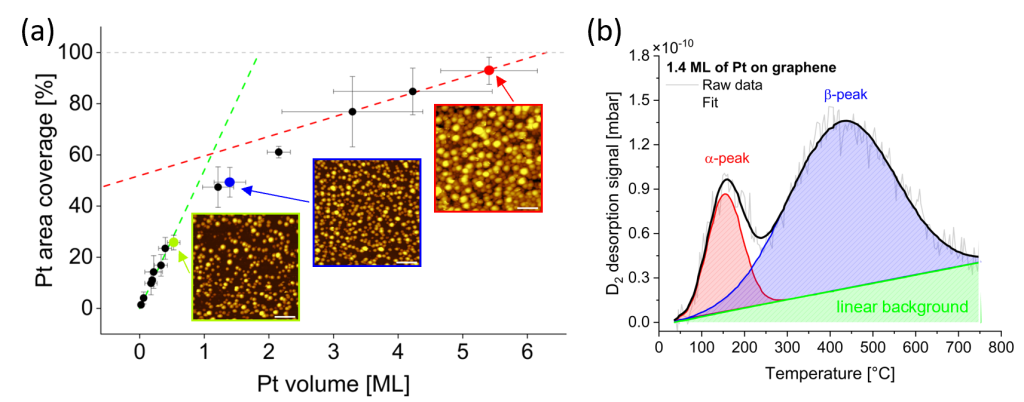Platinum-Decorated Graphene: Experimental Insight into Growth Mechanisms and Hydrogen Adsorption Properties
The application of graphene as hydrogen-storage media has driven research to push its intrinsic properties via functionalization towards an enhanced hydrogen-storage capacity.
Adsorption of molecular hydrogen by van der Waals forces (physisorption) on bare graphene shows very low capacity due to rather low binding energies. This problem can be overcome through decoration of graphene with metals, in particular alkali metals (such as Li and Rb). The latter tend to form 2D layers on the surface of graphene which increases the interlayer distance between graphene sheets and, as theoretically calculated, increases the physisorption binding energy.
On the other hand, hydrogen adsorption on bare graphene via chemisorption involves the formation of covalent bonds between atomic hydrogen and carbon atoms, allowing a very efficient storage of hydrogen. However, chemisorption of molecular hydrogen on graphene presents high barriers because dissociation of the hydrogen molecule is required. Decoration of graphene with transition metals, like Ti or Pt, can increase the storage capacity of graphene and at the same time decrease the chemisorption energy barrier, thus allowing molecular hydrogen to be stored even at near ambient conditions.
For this latter process, we studied graphene decoration with Pt. We used monolayer graphene epitaxially grown on SiC(0001). We have first focussed on examining the process of Pt cluster formation on epitaxial graphene via STM. Depositing increasing amount of Pt on the graphene surface we unveiled two primary pathways for Pt cluster growth (refer to Fig. 1a). Initially, up to about 1 ML of Pt coverage, Pt tends to randomly disperse and cover the graphene surface, while the cluster height remains essentially unchanged. Beyond a coverage of 3 ML, the nucleation of new layers on existing clusters becomes predominant and the clusters mainly grow in height.

Figure 1: (a) Pt cluster growth on graphene. Area coverage [%] vs. Total cluster volume [ML]. All data points are the result of a statistical analysis of several STM images of size (100 nm × 100 nm). The error is calculated as the standard deviation for each dataset. Insets: STM scans of (100 nm × 100 nm) areas representative of the surface with a Pt content 0.53 ML – 26% (green), 1.39 ML – 49%, and 5.4 ML – 93% (red). Colours for the frames of STM images have been used accordingly to the colours of the data points highlighted in the graph. (b) TDS spectrum of hydrogen desorption from Pt clusters supported on graphene. Two Gaussian functions (red and blue curves) and a linear background (green curve) describe the data well.
We then proceeded to assess the suitability of the system as hydrogen storage material. We exposed the Pt-decorated graphene samples to molecular hydrogen and then performed Thermal Desorption Spectroscopy (TDS) on the hydrogenated system. We first observed that as the Pt coverage increases, the full integrated desorption signal continues to rise steadily. However, it eventually levels off around 87% of Pt area coverage (4.23 ML). The desorption spectrum (shown in Fig. 1b) reveals the presence of multiple hydrogen adsorption mechanisms. Two peaks, at 150°C and 430°C, superimposed on a linearly increasing background are clearly visible. These measurements demonstrate the ability of Pt-functionalized graphene to store molecular hydrogen and at temperatures that are high enough for stable hydrogen binding at room temperature.
Publications:
- Letizia Ferbel: Surface reconstructions induced by Rb on Si(111), Master Thesis, University of Pisa, Italy.
- Letizia Ferbel, Stefano Veronesi, Stefan Heun: Rb-induced (3×1) and (6×1) reconstructions on Si(111)-(7×7): A LEED and STM study, arXiv:2201.00735 [cond-mat.mtrl-sci].
- Letizia Ferbel, Stefano Veronesi, Stefan Heun: Rb-induced (3×1) and (6×1) reconstructions on Si(111)-(7×7): A LEED and STM study, Surface Science 718 (2022) 122011.
- Letizia Ferbel, Stefano Veronesi, Ylea Vlamidis, Antonio Rossi, Leonardo Sabattini, Camilla Coletti, Stefan Heun: Platinum-Decorated Graphene: Experimental Insight into Growth Mechanisms and Hydrogen Adsorption Properties, arXiv:2309.15637 [cond-mat.mtrl-sci].
- Letizia Ferbel, Stefano Veronesi, Ylea Vlamidis, Antonio Rossi, Leonardo Sabattini, Calilla Coletti, and Stefan Heun: Platinum-decorated graphene: Experimetal insight into growth mechamisms and hydrogen adsorption properties, FlatChem 45 (2024) 100661.
Presented at:
- Letizia Ferbel: Surface reconstructions induced by Rb on Si(111), Master Thesis defense, University of Pisa, Italy, 02 October 2020. [Talk]
- Letizia Ferbel, Stefano Veronesi, Stefan Heun: Rb-functionalized epitaxial graphene on SiC(0001), chem2Dmat, Virtual Online Conference, 31 August – 03 September 2021 (oral). [Abstract] [Talk]
- L. Ferbel, S. Veronesi, A. Rossi, C. Coletti, S. Heun: Platinum-covered graphene as hydrogen storage medium, 36th European Conference on Surface Science, Lodz, Poland, 28 Aug – 1 Sep 2023. [Abstract] [Talk]